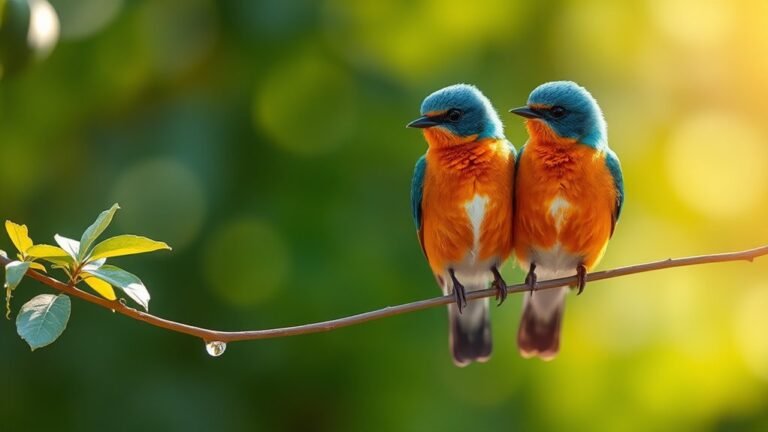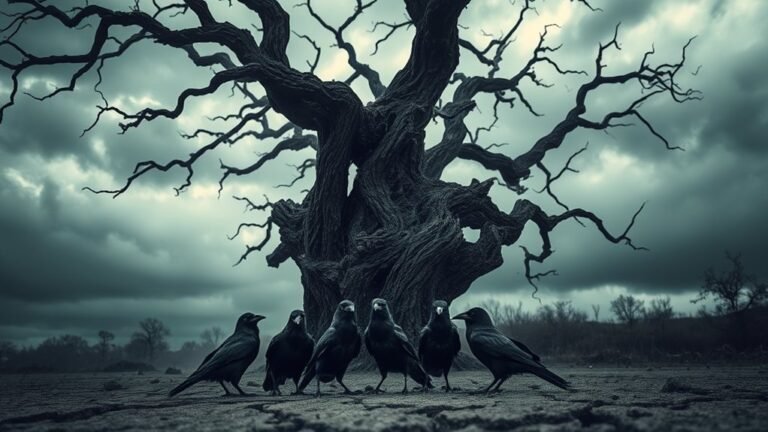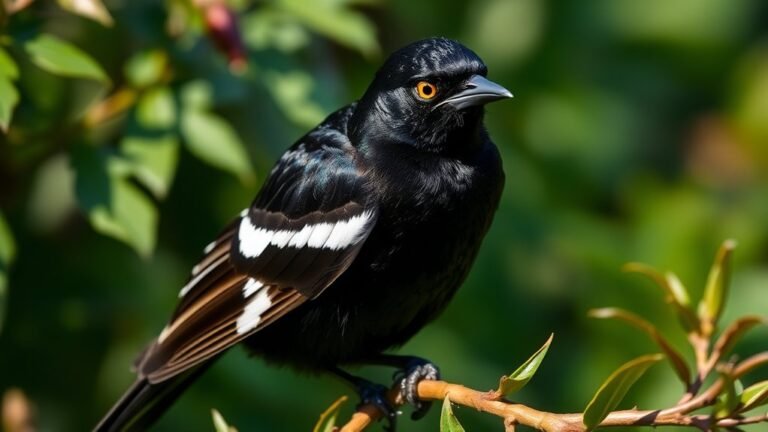Birds of Montana: 12 Species Guide With Photos
As you explore the birds of Montana, you will see impressive species like the Bald Eagle and the Mountain Bluebird. These birds adapt well to their different habitats. Each type of bird, such as the Western Meadowlark and the Barn Owl, plays an important role in Montana's ecosystem. Learning about their behaviors and habitats can increase your enjoyment and understanding. Discover what makes each species unique in this guide.
Key Takeaways
Montana hosts many bird species, including the American Robin and Bald Eagle. These birds have distinct behaviors and habitats. The Western Meadowlark sings a cheerful song and sports vibrant colors, making it a standout in Montana's prairies. You can often spot Mountain Bluebirds with their bright blue feathers perched on fence posts in open areas.
Conservation efforts play a vital role in protecting species like the Bald Eagle, which experiences habitat loss. Seasonal migrations, such as those of the Scarlet Tanager and American Robin, showcase Montana's active avian ecosystem.
Birdwatching in Montana offers a chance to appreciate these species up close and learn about their unique roles in the environment.
American Robin
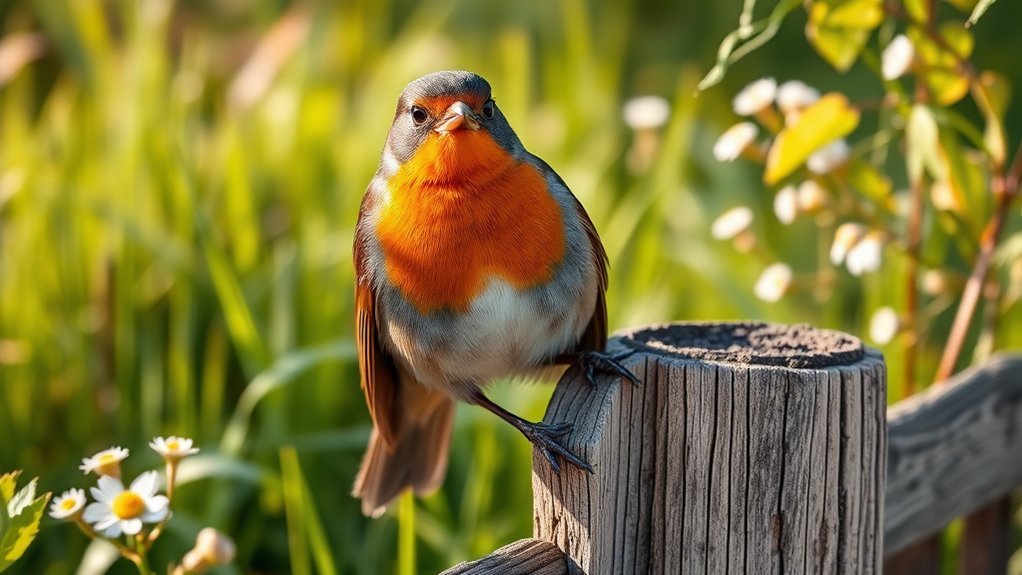
The American Robin is a colorful bird easily recognized by its red-orange breast. You can often see it hopping on lawns.
Robins search for worms and berries, sometimes in pairs, highlighting their friendly nature.
In winter, they migrate to warmer areas, traveling hundreds of miles. This migration shows their ability to adapt.
Watching robins connects you to nature and its cycles. Their presence helps you enjoy the simple beauty around you.
Bald Eagle
The Bald Eagle is one of Montana's most majestic birds. Its large wingspan and striking white head attract many observers. You can often see these raptors flying high above rivers and lakes as they hunt for fish, which is a key part of their diet. They've sharp eyesight and effective hunting skills that highlight their nature.
Bald Eagles build large nests in tall trees, and they often reuse these nests for many years. Sadly, their populations face threats from habitat loss and pollution. This makes it important to conserve Bald Eagles. Participating in local conservation efforts can help protect their homes and ensure future generations can enjoy these stunning birds.
Each time you see a Bald Eagle, you connect with Montana's beautiful wildlife and the conservation efforts aimed at preserving it.
Western Meadowlark

After admiring the Bald Eagle, you may find the Western Meadowlark captivating. This vibrant yellow bird features a unique black "V" on its chest and thrives in Montana's grasslands and open fields.
Its cheerful song consists of a series of whistles that echo across the plains. This song marks its territory and attracts mates. Western Meadowlarks prefer areas with low grasses and scattered shrubs, where they search for insects and seeds.
When you see one perched on a fence post, appreciate how it blends into the landscape. Its presence reflects Montana's wild beauty.
Take a moment to listen to its melodic tunes, which truly capture the spirit of the prairie.
Mountain Bluebird
As you walk through Montana's open landscapes, you might see the Mountain Bluebird. This bird has bright blue feathers that stand out in its natural habitat of grasslands and sagebrush hills.
You can often find them on fence posts or low branches, looking for insects to eat. Mountain Bluebirds often stay in pairs or small flocks, especially during breeding season.
Their cheerful calls and flight patterns make them a joy to watch. Bring your binoculars and enjoy spotting this beautiful blue bird!
Black-capped Chickadee
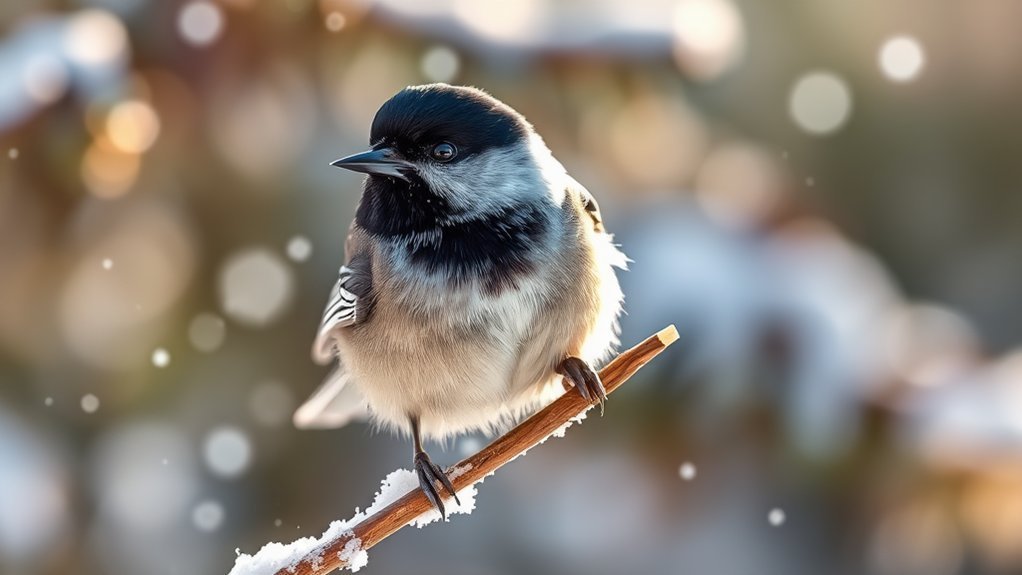
Have you seen a Black-capped Chickadee in the pine trees? These small birds are fun to watch, especially in winter when food is hard to find.
They've a distinctive black cap and white cheeks, making them easy to identify. Chickadees often visit bird feeders, where they cling to the seed holders, take seeds, and hide some for later.
They're curious and may even approach you if you stand still. Observing them in their natural habitat brings a sense of connection to nature.
Setting up a bird feeder is a great way to invite these friendly birds into your yard.
Common Yellowthroat
The Common Yellowthroat sings a bright melody, making it easy to spot in wetlands and thick bushes. This small warbler moves quickly through dense plants, using them for safety from threats.
It lives in marshes, cattail areas, and wild fields, where it finds plenty of food like insects and spiders. Watch for its unique "cackle" call and tail flicks while it searches for food.
Males wear a black mask, helping you identify them as they sing to mark their territory. Seeing a Common Yellowthroat can help you appreciate Montana's wide range of birds.
If you're near water, listen closely; these lively birds provide a joyful sound to nature.
Red-tailed Hawk
While exploring Montana's habitats, you may see the Red-tailed Hawk flying overhead. This large bird thrives in open fields, forests, and grasslands.
It often sits on trees or fence posts, looking for movement. Red-tailed Hawks use their sharp eyesight and strong talons to spot small mammals, birds, and reptiles from high above. You might see them hover as they look for hidden prey in the grass.
These adaptable birds enjoy various environments, making them a favorite for locals and visitors. Keep watching—you may catch their impressive flight against Montana's stunning landscape.
Lewis's Woodpecker
As you explore the woodlands of Montana, look for the colorful Lewis's Woodpecker. This bird has an iridescent green-black back and a bright pink chest. It prefers open forests and often nests in old trees near grasslands or riverbanks.
The Lewis's Woodpecker mainly eats insects, particularly ants and beetles, but it also likes fruits and nuts. You may see it catching insects in mid-air or pecking on tree bark for hidden food.
Watch for its unique "hawking" technique, where it snatches insects while flying.
Spotting the Lewis's Woodpecker adds to your experience of Montana's diverse birdlife. Enjoy your time in these beautiful woodlands!
Barn Owl
The Barn Owl has four key features that make it easy to identify in Montana's night skies.
Its heart-shaped face helps it hear sounds very well, allowing it to find small animals hiding in the grass. Barn Owls live in open fields, farms, and old barns, which provide them with the privacy they need.
They mainly eat small mammals, like voles and mice, helping control rodent numbers. If you see one gliding silently at dusk, it's a stunning example of nature's adaptability.
Watching these owls can deepen your understanding of Montana's ecosystems and connect you to the life around you.
Scarlet Tanager
The Scarlet Tanager is a beautiful bird found in Montana's forests during the summer. Its bright red body and black wings make it stand out.
This bird prefers rich, deciduous forests with plenty of leaves and fruit-bearing plants. The Scarlet Tanager migrates from Central and South America and returns to Montana every spring.
Its clear songs create a pleasant sound in the forest. This bird feeds mainly on ripe berries and insects, showing its ability to thrive in different environments.
Learning about its migration helps you connect with nature and appreciate these stunning birds.
Clark's Nutcracker
Clark's Nutcracker is a unique bird found in the high western mountains. This medium-sized bird shows great intelligence and adaptability.
You can find it in mountainous forests, especially among coniferous trees. The bird is well-suited to harsh conditions and displays an impressive skill in caching seeds. Clark's Nutcracker buries thousands of seeds each year and retrieves them during winter.
Its gray plumage and bold black wings make it easily identifiable, and its loud, varied calls resonate across the alpine environment.
Explore the rugged beauty of the mountain areas where these fascinating birds live and thrive.
Great Horned Owl
The Great Horned Owl is a well-known bird of prey. It has a strong presence and unique tufted "horns." This owl lives in many environments, including forests and open areas, showing its ability to adapt.
Great Horned Owls are mostly active at night. They've large eyes and excellent hearing, which help them hunt in the dark.
When hunting, these owls sit quietly and watch for food, like rabbits and rodents. Their strong talons help them catch prey quickly, and their silent flight makes it easier to sneak up on animals.
Great Horned Owls are also famous for their deep hoots that resonate at night, creating a connection to the wild surroundings in places like Montana.
Frequently Asked Questions
What Are the Best Times to Observe These Birds in Montana?
To observe birds in Montana, visit during peak times, which are dawn and dusk. These times offer the best chances to see birds actively feeding and moving. Additionally, spring and fall migrations are great opportunities to see a variety of bird species in Montana's diverse habitats. Plan your visits accordingly for an enjoyable birdwatching experience.
Are There Specific Habitats Where These Species Are Commonly Found?
Many bird species are commonly found in wetland habitats. These areas have diverse vegetation that supports their needs. Additionally, mountain forests offer shelter and food for birds. These habitats create rich ecosystems and provide opportunities to connect with nature. Enjoying the sights and sounds of these birds can enhance your outdoor experience.
How Can I Identify Birds by Their Calls and Songs?
To identify birds by their calls, listen for unique patterns and pitches. Take notes when you hear different sounds. You can use apps to help match these sounds to specific birds. This practice will deepen your connection to nature and improve your ability to recognize bird communications. Enjoy the process of discovering the beauty of bird calls around you.
What Season Is Ideal for Birdwatching in Montana?
Spring is the best season for birdwatching in Montana. During spring migration, many colorful bird species return while some wintering birds stay a bit longer. This time of year offers a variety of birds and interesting behaviors to observe. Birdwatchers will have a rewarding experience spotting and enjoying these beautiful creatures.
Are There Any Local Birdwatching Groups or Tours Available?
Yes, there are local organizations in Montana that offer guided birdwatching tours. These groups allow you to connect with other birdwatchers. Participating in these tours helps you learn more about bird species and the habitats they live in. Joining a group can make your birdwatching experience more enjoyable and informative.

Kashvi is a passionate bird enthusiast and nature lover who has been fascinated by the world of birds for years. With a keen eye for detail and a love for learning, Kashvi is dedicated to sharing her knowledge and insights with fellow bird enthusiasts on Avian Enthusiasts. Through her engaging and informative articles, Kashvi aims to inspire others to join her in exploring the fascinating world of birds and to promote a deeper appreciation for these incredible creatures.



